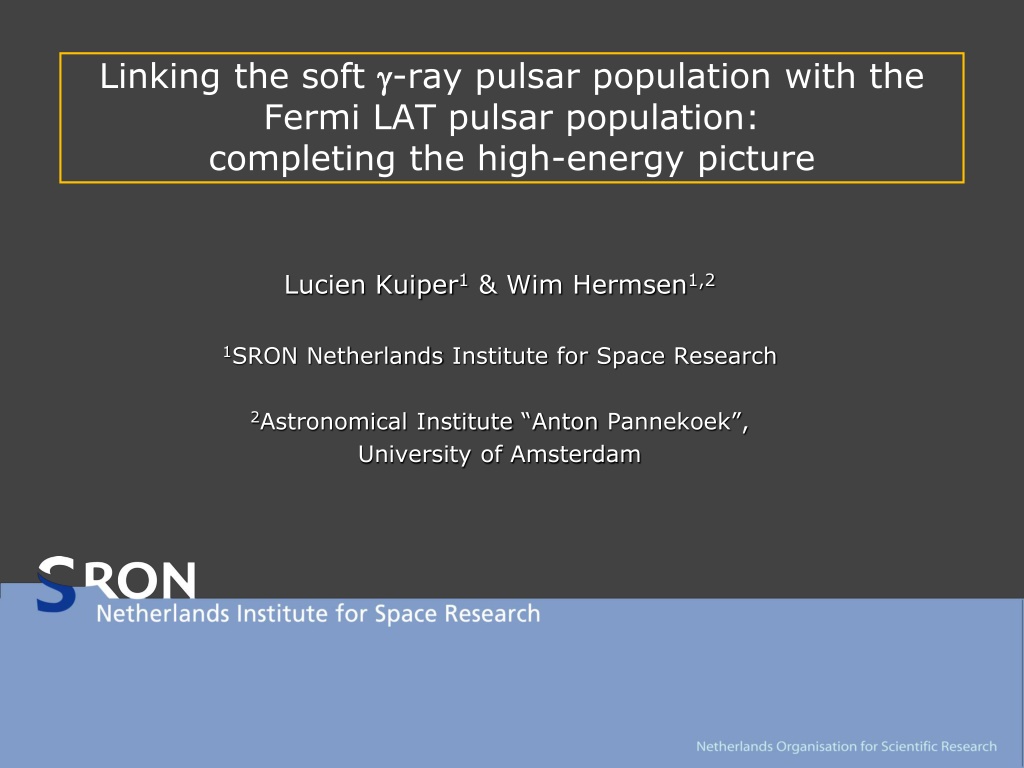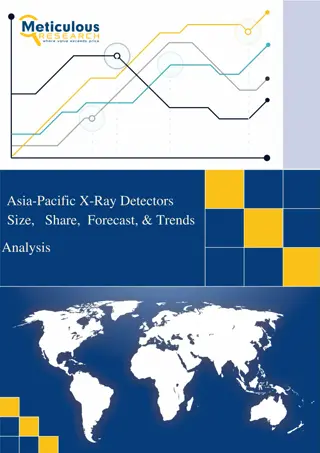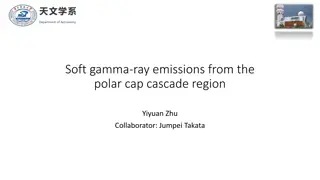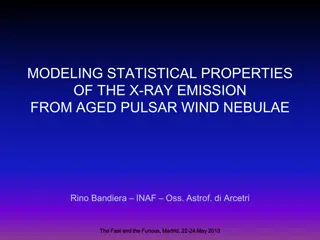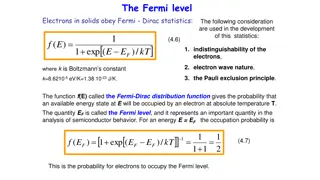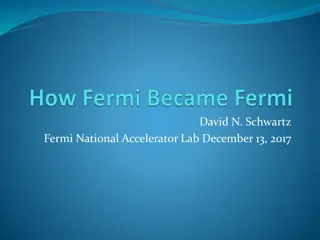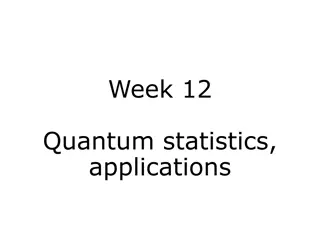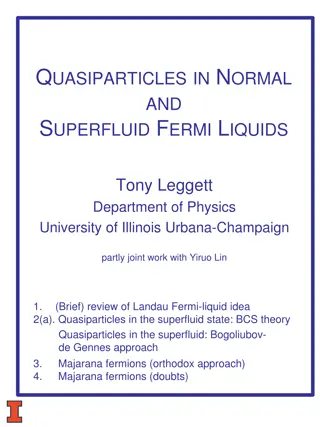Linking Soft-Ray Pulsar and Fermi LAT Pulsar Populations
This research presentation explores the connection between the soft-ray pulsar population and the Fermi LAT pulsar population, focusing on observational data and methodologies for increasing the sample size to enhance our understanding of high-energy pulsars. The study outlines the identification process of soft-ray pulsars (>20 keV) through sensitive X-ray instruments, emphasizing the importance of follow-up observations for confirmation. By comparing different pulsar populations, the study aims to paint a comprehensive picture of high-energy pulsars.
Download Presentation

Please find below an Image/Link to download the presentation.
The content on the website is provided AS IS for your information and personal use only. It may not be sold, licensed, or shared on other websites without obtaining consent from the author. Download presentation by click this link. If you encounter any issues during the download, it is possible that the publisher has removed the file from their server.
E N D
Presentation Transcript
Linking the soft -ray pulsar population with the Fermi LAT pulsar population: completing the high-energy picture Lucien Kuiper1& Wim Hermsen1,2 1SRON Netherlands Institute for Space Research 2Astronomical Institute Anton Pannekoek , University of Amsterdam
Outline of presentation Introduction Fermi LAT (>100 MeV) pulsar population Observational status of pulsar emission in the hard X-ray / soft -ray window (> 20 keV) Work horses Increase of sample: How? Current (secure) member list PSR J2229+6114 and IGR J18490-0000 Zoom-in on some recent 'new' members AX J1838.0-0655, Population comparisons Summary & conclusions "The fast and furious", ESAC-Workshop, Madrid, 22-24th May 2013 2
High-energy -ray (>100 MeV) pulsar population 2ndFermi LAT Pulsar Catalogue: # 117 Sample used in this work: # 101 Preliminary from https://confluence.slac.stanford.edu/ display/GLAMCOG/Public+List+of+LAT- Detected+Gamma-Ray+Pulsars Radio-loud : 41 Radio quiet: 36 Ms pulsars : 40 (recycled) Young pulsars: 77 (non-recycled) Maximum luminosity at GeV energies Credit: Fermi pulsar team "The fast and furious", ESAC-Workshop, Madrid, 22-24th May 2013 3
Soft -ray pulsar population (> 20 keV) Step 1 Identification of energetic point-sources in supernova remnants (radio), unidentified CGRO EGRET/LAT (>100 MeV), INTEGRAL (>20 keV) or HESS/VERITAS/Magic (> 300 GeV) error regions by using the sensitive X-ray instruments aboard Chandra, RXTE, XMM-Newton and Suzaku Step 2 Follow-up with instruments with sensitivity above ~20 keV: Workhorses With presently available sensitivities long exposures are required, sometimes summing (archival) data collected over years from: a) b) c) d) RXTE PCA RXTE HEXTE INTEGRAL IBIS ISGRI NuStar ( 2 - 60 keV; non-imaging) (15-250 keV; non-imaging) (15-300 keV; imaging) ( 3 - 80 keV; imaging) [e) f) Suzaku HXD PIN Swift BAT (12 - 60 keV; non-imaging) (15-150 keV; imaging)] Good imaging is required to avoid source confusion, particularly in Galactic Plane regions, and to disentangle pulsed and DC (PWN) emission "The fast and furious", ESAC-Workshop, Madrid, 22-24th May 2013 4
Soft -ray pulsar population (> 20 keV): 15 members "The fast and furious", ESAC-Workshop, Madrid, 22-24th May 2013 5
AX J1838.0-0655 Discovered in 2008 as an energetic 70.5 ms X-ray pulsar using RXTE PCA data (ATEL #1392; Gotthelf & Halpern (2008)) Associated with HESS J1837-069 9.9 Characteristic age: 22.6 kyr Hard X-ray photon index ~ 1.36(2) at 14.2 keV (Kuiper & Hermsen 2013; in prep.) 5.3 Since discovery RXTE monitoring pulsar ephemeris 9.7 7.2 3.3 Ms Since its discovery a large timing glitch has been detected (Atel #2446; Kuiper & Hermsen)! "The fast and furious", ESAC-Workshop, Madrid, 22-24th May 2013 6
Decoupling pulsed/DC spectra underlying PWN spectrum! DC spectrum breaks above ~50 keV Total emission from AX J1838.0-0655 Suzaku XIS 0.7-10 keV (42.2 ks): =1.27 0.11; Anada et al. (2009) INTEGRAL ISGRI 20-300 keV : =1.72 0.07; this work; consistent with Malizia et al. (2005) "The fast and furious", ESAC-Workshop, Madrid, 22-24th May 2013 7
PSR J2229+6114: the energetic young pulsar in 3EG J2227+6122 Discovered by Halpern et al. 2001 in unid. EGRET error region at radio freq. and at X-rays (ASCA): P = 51.6 ms; c=10.5 kyr Bright PWN (see below) 12.3 Pulsations, also detected now by AGILE and Fermi above 100 MeV: a broad asymmetric pulse Recent detection of extended TeV emission with Veritas (VER J2227+608) from near environment 8.2 2.5 Archival RXTE PCA/HEXTE data reveal pulsed emission up to ~30 keV using ~220 ks exposure with hard spectrum, photon index = 1.11(3) 95 ks CXO ACIS-I "The fast and furious", ESAC-Workshop, Madrid, 22-24th May 2013 8
IGR J18490-0000 I) Chandra HRC-SI Nov. 20, 2011 (25.1 ks) II) Chandra ACIS-S Nov. 16, 2012 (22.7 ks) Goals: 1) Evidence for diffuse emission? 14.5 2) Pulsed fraction? (reported; Pf~ 0.25 PCA based; Gotthelf et al., 2011) No pronounced diffuse emission seen in HRC-S data Pf= 0.77 +/- 0.04 "The fast and furious", ESAC-Workshop, Madrid, 22-24th May 2013 9
IGR J18490-0000: Chandra ACIS-S spatially resolved spectral analysis 2-10 keV HE-spectrum (Total; unabs. ) ACIS-S (5" source): 1.08+/- 0.02 2 circular "bg" regions (r = 60") and 2 rectangular "diffuse" PWN emission extraction regions (150" x 65" and 75" x 37.5" minus 5" radius source region) : Weak, hard PWN emission = 1.18 +/- 0.05 about 5 x weaker than PSR emission EPIC MOS 1+2 : 1.13 +/- 0.01 EPIC Pn (SWM) : 1.23 +/- 0.01 Pulsed EPIC Pn (SWM) : 1.14 +/- 0.01 "The fast and furious", ESAC-Workshop, Madrid, 22-24th May 2013 10
Soft -ray pulsar characteristics Profile morphology: Spectral view (1 keV 10 GeV) Single sharp pulse : #2 Two (sharp) pulses : #3 (All LAT) Multiple sharp : #1 (Vela; LAT) Single (structured) : #9 (1509-58;LAT) broad pulse 1509-58 AX J1838.0-0655 0205-6449 IGR J18490-0000 2229+6114 1846-0258 Maximum luminosity at MeV energies! "The fast and furious", ESAC-Workshop, Madrid, 22-24th May 2013 11
35.70 +/- 1.05 37.46 +/- 0.66 Light grey: Fermi LAT pulsars (76 entries) Dark grey: Soft -ray pulsars (16 entries) Spin-down luminosity (non-recycled) 12.35 +/- 0.37 12.49 +/- 0.48 ~60 x more energetic 3.78 +/- 0.52 4.80 +/- 0.76 Characteristic age/time scale Surface magnetic field strength ~10 x "younger" Comparable distributions! "The fast and furious", ESAC-Workshop, Madrid, 22-24th May 2013 12
Summary & Conclusions The number of pulsars detected at soft -rays has increased to 15 [+1] Above 100 MeV now more than 117 pulsars detected by Fermi LAT, only 5 pulsars in both samples The soft -ray pulsar population is younger and more energetic than the LAT one Soft -ray pulsars reach max. luminosity at MeV energies, the LAT pulsars do so in GeV range The large majority of the soft -ray pulsars has single broad (asymmetric/ structured) pulses contrary to the LAT pulsars, showing mainly double pulses Soft -ray pulsars are in general associated with bright X-ray/TeV PWNe The current missions sensitive for hard X-rays are not / hardly sensitive enough to detect the GeV-pulsars need more sensitive missions (NuSTAR; Astro-H; AstroSat; LOFT; and MeV missions like e.g. DUAL, GRIPS) Open questions: Why no detection of pulsed non-thermal X-ray emission (>2 keV) from PSR J1119-6127, (1.6 kyr) PSR J1357-6429 (7.3 kyr) and PSR J1124- 5916 (2.9 kyr), while we have Fermi LAT detections and TeV detections of two? Instead soft pulsed X-ray emission (< 2 keV; thermal?) has been detected What about: PSR J1833-1034 (G21.5-0.9): LAT plus TeV/soft -ray (ISGRI) detection, but NO X-ray pulsations "The fast and furious", ESAC-Workshop, Madrid, 22-24th May 2013 13
